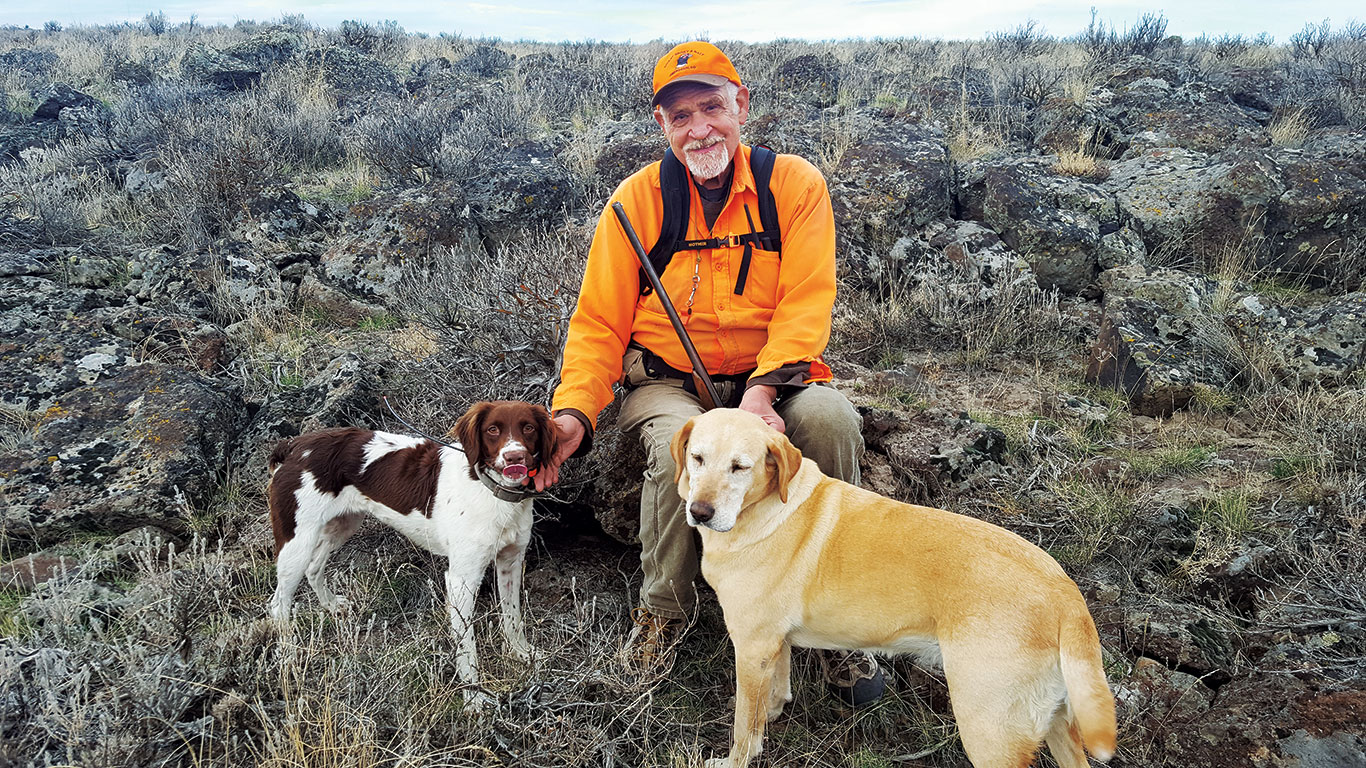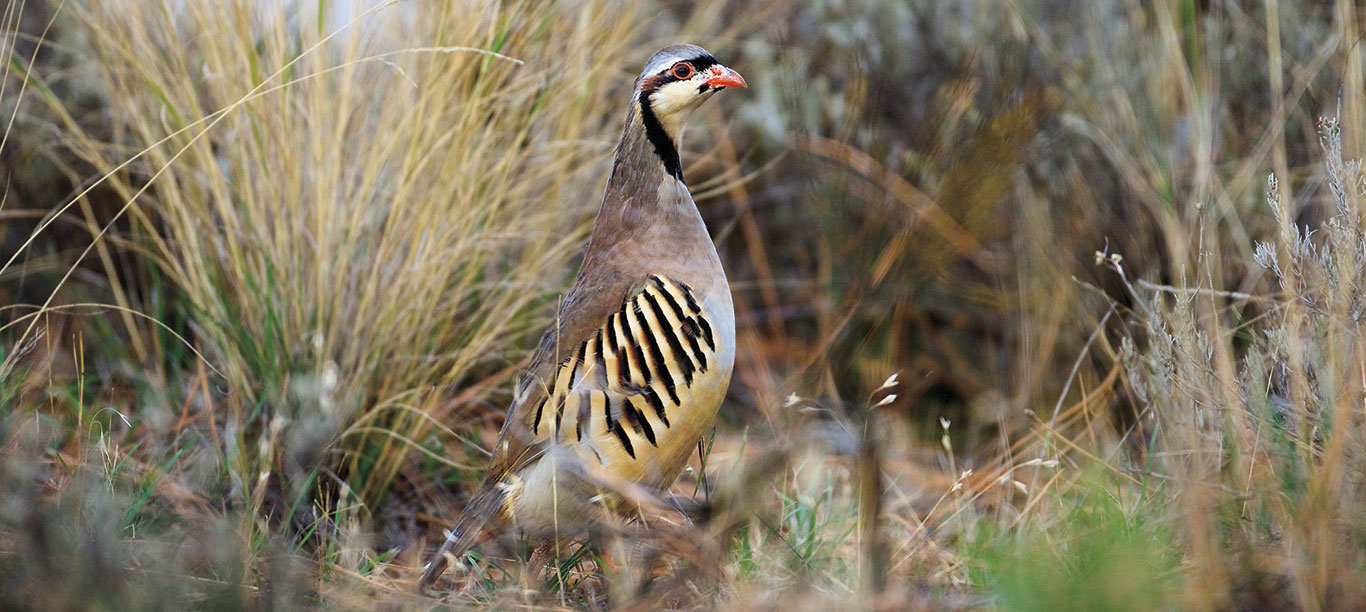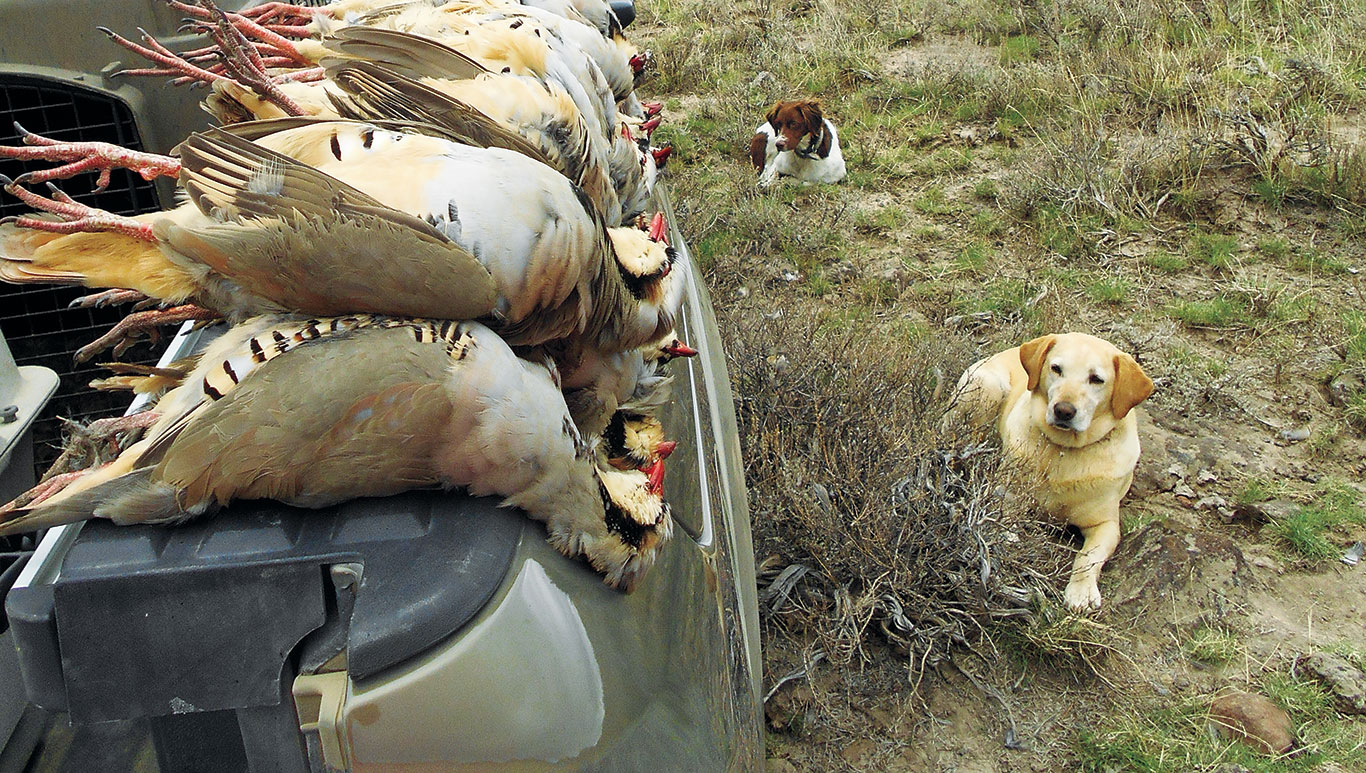I've been a Lab and springer man for 55 years, so before Lucy, the Brittany, I'd had very little experience with pointing dogs. I bought Lucy on a whim, and she has been a joy, pointing since she was nine weeks old.
Her first point was on a robin sitting on a landscaping timber across the yard. After that, she began pointing grasshoppers and bees and even fallen leaves in the driveway if the wind rippled them just right. She loved tweetie birds. Today, at three years of age, she'll still revert to pointing grasshoppers and tweetie birds during the off-season, but she's also done an exemplary job finding and holding pheasants, quail, grouse, grey partridge and most recently, a small cottontail rabbit that has taken up residence in my wood pile.
But there was a dilemma: I also had an eight-year-old yellow Lab, Jill, who was supposed to be a pointing Lab, but who, from the get-go, exhibited no inclination to point. She's a good, loveable old meat dog, though, an excellent retriever, and over the years we've shot a lot of pheasants together.
Having two bird dogs of opposite hunting inclinations was not a good situation for a man who could not bear to leave either of them at home; I just couldn't — a lot of reasons, mostly emotional — no further apologies or explanations. I run them together, and Jill quickly learned that with Lucy working the cover, she had to do nothing but stay beside me until there was a point. Only then would she put on a burst of speed and race in to flush and retrieve whatever Lucy had pointed. While this didn't seem to bother Lucy, who preferred to run off to find another bird, it bothered me.
By the time we were into the bird season a couple weeks last year, I was becoming frustrated and even angry by Jill's actions. "She's going to ruin Lucy," I told my son. "This should be Lucy's breakout season, but I'm afraid she'll start to break off her points so she can beat Jill to the flush."
My family and I were hunting pheasants in South Dakota. And while it would have been unthinkable to leave Jill at home, I really wanted to give Lucy a lot of work on wild pheasants. I wanted to see her lock up and hold a point until I made the flush or commanded her to. I thought perhaps Jill would hunt with my son, but Jill would not leave my side, forsaking hunting altogether so she could keep an eye on the younger dog. Whenever Lucy pointed, she would race in, often before I could get close enough for a shot.
Because Lucy ranged so far and held a point so well, and because I often hunted pheasants in thick cover where I couldn't see her, I bought an electronic collar with a "locate" button. Not until I got it home and tried it a few times did I realize the frequency was out of my range; I couldn't hear the tone. If I wanted to hunt Lucy on pheasants in thick cattails or quail in heavy sagebrush, I needed to take a young friend with me — someone who hadn't destroyed his ability to hear the higher frequencies by hunting 40 years without hearing protection.
Young friends weren't always available, so I solved this problem by buying a Garmin GPS collar. It cost me almost $800, but I no longer had to wonder what my dog was doing. The unit told me where Lucy was, how far away, and in what direction. I carried it in a shirt pocket and it vibrated when she was on point.
Jill loved the unit too because now she had only to listen for the vibrations to know Lucy was on point. This allowed her to find Lucy's birds much quicker, and it became all but impossible to get a decent shot over a point. It seems I had taken a step backwards. I know, I know — leave the Lab at home, you say, but I couldn't do it.

At age 72, I never thought I'd hunt chukars again, so it is amazing that it was a three-day chukar hunt in eastern Oregon that gave me the inspiration to rethink the Lucy-Jill-Alan relationship. Friend Mark Midtlyng called from his home in Caldwell, Idaho. "You've got to get down here," he said. "I've found some really good chukar areas in Oregon about two hours from my house."
"I don't hunt chukars anymore, Mark," I said sadly. "Those hills kick my butt."
"It's pretty flat," Mark assured me. "Rolling sagebrush mostly. Oh, there are canyons, but I can drive to the top and we can have pretty decent success by walking the ridges."
"Flat?" I questioned. Mark is 20 years younger than I and has a tendency to let his enthusiasm trump reality when it comes to anything hunting. He, for example, has sent me off in search of a canyon that was "only a half mile from here" that turned out to be a good two miles away. His definition of flat was a place where you didn't need ropes to ascend.
"I promise," Mark enthused. "It's like a tabletop in places."
I bit. The following Thursday I met Mark's friend, Brian Quinnett, in Moscow, Idaho, and we drove the 250 miles to Caldwell, Idaho. Brian is about the same age as Mark — 50 — a former NBA basketball player who likes to chase chukars as much as Mark. Even he was skeptical of Mark's description of our hunting area in eastern Oregon.
We spent the night at Mark's home in Caldwell, got up early, and were standing on a flat but rocky sagebrush-covered ridge at dawn.
"I can't believe it," I said as we released the dogs from their crates. "It is flat!"
"Have I ever lied to you?" Mark asked.
"Usually," I said. "But this is a pleasant exception."

Mark hunts with a Chesapeake Bay retriever — not everyone's ideal chukar dog, but it works for him. Brian has a vizsla and a black Lab. As I collared Lucy, he discussed the merits of hunting with a pointer and a retriever.
"I actually like it a lot for chukar hunting," Brian told me. "My vizsla, Penny, hunts big but doesn't retrieve, and my 'pointing Lab,' Scout, hunts close but doesn't point. He loves to retrieve, though." The pair complemented one another beautifully, Brian told me, as Scout could be called back to heel when Penny went on point. Seven years previously, that would have worked with Jill, too, but we hadn't done the heeling drill for many years, and Jill had conveniently decided "Heel!" had no particular urgency.
Separated by about 400 yards, we began a wide sweep of the first ridge. After about a half mile, the GPS indicated Lucy was on point 154 yards to my right. Jill heard the vibration and had moved out front, looking for her. Not making visual contact, she returned to her happy place next to my left leg.
I tried to keep the same pace so as to not arouse her suspicion as I turned toward the pointing dog, and when I saw her, I used my body to obscure Jill's vision. Nevertheless, she caught the scent at 20 yards and charged in, flushing a flock of perhaps 25 chukars.
It wasn't optimum, but it wasn't terrible, either, and I doubled on the rise — my first chukars since I had given the sport up four years previously, and the first chukars I had ever killed with both feet on level ground.
Immediately, Lucy was off looking for singles rather than hunting for the downed birds, but Jill did her job, bringing one back immediately and then poking around in the sagebrush until she found the other.
"If I could keep the Lab reined in, I'd have a pretty good chukar tag team," I told Brian when we came together to compare notes. He and Mark had both taken birds on the fly-by.
"Well, why don't you just leash her when there's a point?" Brian asked.
Well, duh! It was so simple I hadn't considered it.
"Just don't fasten the leash to your belt," Mark grinned. "My dad did that once and when the birds got up, his Lab pulled him off his feet."
I dug a short leash out of my bird vest and put it in my pocket. The next time Lucy went on point, I pocketed the GPS, laid my gun down, tethered Jill, picked up the gun and walked in with the leash in my hand. When we were 10 feet from Lucy, I dropped the leash and Jill did her thing. I shot one, missed one and had time to load one barrel and get another. Before I could extract the last empty, my Lab was shoving the first chukar into my hand.

By the end of the first day, however, I knew I had to tweak the system, as Jill had discovered that if she pulled back on the leash, the collar would slip off over her head and she was free again to make the flush. I tightened the collar, but she just sat down and planted her feet, and when I pulled, the collar again came off over her head.
That night, I visited Wal-Mart in Caldwell and bought a choke chain. The next time Jill planted her feet, the collar tightened, and after a few rodeos, she decided to behave. From that point on I, rather than a yellow dog, made the birds flush.
These days, my tag-team duo will team up on anything with feathers. We haven't been back to eastern Oregon for chukars, but it's on my to-do list for next year. Jill doesn't particularly like being leashed when Lucy is on point, but they are working well together — Lucy doesn't have to retrieve and the aging Jill doesn't have to hunt.
We have become a pretty effective, if not traditional team — one dog running big and one walking on my heels. I know dog trainers and field trialers will wince when they see us afield, but I've always cared more for meat dogs than field trialers, and my dogs and I are teaming up for a lot of wild birds.
It's hard to argue with success.






